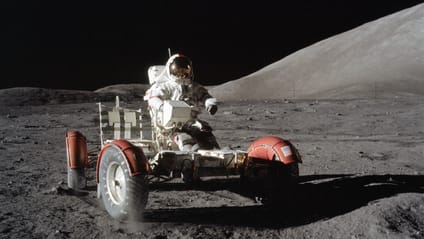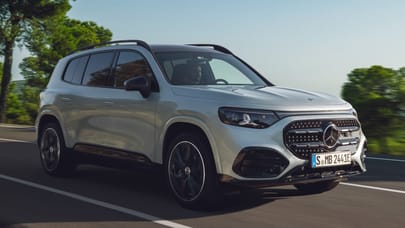
Seven reasons why the Lunar Rover is the coolest EV ever
As fast, fancy or expensive as any other EV might be, the Lunar Rover is still the G.O.A.T


More than a century after its introduction, a century since its quiet death and decades since its fledgling rebirth, electric power is, at last, cool. As you can imagine, it’s been a long journey with plenty of missteps (*cough* EV1) along the way, but we’re now at a point where we’re confident in saying that volts are just as cool as V-power.
Of course, you could say that, in the right circles, it’s cooler. But you could just as easily say that in the right circles, it’s the antichrist, coming for your freedom. So let’s hit the middle ground and say for Middle England, Middle America and the non-middy-drinking sections of Australia, electric power is cool.
If a car claims to be fast, we immediately need to find which is the fastest. If something is expensive, we immediately want to know the priciest. And if something is cool, it’s only human nature to feel compelled to say which is the coolest. For us, the coolest EV can only be the Lunar Rover. Here’s why.
Advertisement - Page continues belowIt was the most exclusive EV ever made

It cost $38m to build just four of them, just three went into service and you had to be a literal astronaut to drive one.
Now consider this: where’s the coolest place you’ve ever driven? The Nurburgring? Autobahn? Laguna Seca? How about a place that’s literally otherworldly, a place where only 12 people have ever set foot and only a fraction of that number have ever driven.
Two of the most famous astronauts – Messrs Armstrong and Aldrin – had to use two feet and a heartbeat. It wasn’t until Apollo 15 that the moon buggy made its debut, and the Apollo program was all over after Apollo 17. So just three missions, three drivers and three co-drivers. Kinda makes those invite-only Ferraris seem a bit common and easily achieved, no?
It was astronomically powerful... in a way

The Lunar Rover had a single horsepower and a top speed of about 11 miles per hour – so long as there was no air resistance and only lunar gravity weighing it down. But then again, it weighed just 210kg, which puts its power-to-weight ratio at 4.75bhp per tonne.
OK, that’s not exactly astronomical. But that’s its power-to-weight ratio on Earth. Take it to the Moon, where its weight barely registers 35kg, the power-to-weight increases... um, astronomically. There’s more than 28bhp per tonne up there on the Lunar surface, more than the contemporary Honda Super Cub back on Earth. And the Cub’s the best selling vehicle of all time.
Still not impressed? OK, fine – the first stage of the Saturn V rocket generates 7,891,000lb ft of thrust. So yeah, astronomical power.
Advertisement - Page continues belowIt’s singularly focused

Modern cars are generally excellent, in terms of reliability and economy and so on, but they’re also excellently general. Specificity (and the multi-car garage) has fallen by the wayside, and it’s not hard to see why. City cars aren’t cowed by highways, hatchbacks are now properly family-sized and hardcore off-roaders have been softened to the point where a 2.5-tonne Land Rover isn’t an absurd choice of family car for soccer mums and helicopter dads.
And all the while, we’re being bombarded with marketing bumf about ‘heritage’ this, ‘authentic’ that and ‘focused’ the other. Pfft. We’re not getting any of that; we’re getting the physical manifestation of Jack of all trades and master of none.
Not so with the Lunar Rover.
It was the master of a single domain and near-useless in any other. Its tyres were an open mesh of zinc-coated piano wire with titanium chevrons bolted on as ‘tread’. This is great for not getting punctures (even so, the Lunar Rover carried a spare) but likely less so for NVH.
It weighed just 210kg (on Earth; it was a scant 35kg on the Moon), which was pretty useful when it comes to avoiding throwing a massive spanner in the works of Tsiolkovsky’s rocket equation, necessitating an even bigger rocket than the Saturn V – which was already the biggest we’ve ever launched. But to sneak in at that weight meant certain creature comforts like air conditioning, central locking and actually having body panels had to fall by the wayside.
The batteries were non-rechargeable and its drivers were under instruction not to drive anywhere beyond walking distance from where they started in case it broke down. To be fair, that last part might have been because the nearest repair centre was 240,000 miles away.
It might just be us, but specialised tools will always be cooler than masters of none. There’s no need to crow about authenticity because it’s never in doubt to begin with. No one looks at the moon buggy and thinks of any other use but on the Lunar surface. Its exclusive focus is perhaps its most endearing feature.
It’s put in more moon miles than any other

As amazing as the Lunar Rover is, and as amazing as the Apollo and Gemini programs were, it’s impossible not to recognise the achievements and contributions of the Soviet Space Program. The Soviets, to put it bluntly, were kicking America’s caboose when it came to the space race – the first ICBM, the first unmanned satellite (Sputnik 1), the first animal in space (Laika the dog in Sputnik 2), the first man in space (Yuri Gagarin), the first woman in space (Valentina Tereshkova), the first spacewalk (Alexei Leonov) and the first spacecraft to reach the moon (Luna 2) to mention just a few.
You’ll likely know of Gagarin and Sputnik 1, probably about Laika, and less likely Tereshkova and Leonov. But we’re willing to bet that only the proper space nerds (it’s OK, you’re among friends now) know about the Lunokhod program.
And that’s kind of strange, in a way – the Lunokhod 2 holds the record for the furthest distance travelled on the moon by a single vehicle, at 39 kilometres. During the last American mission to the moon, Apollo 17, the astro-Yanks put in nearly 36 kilometres with their moon buggy. But the other two Lunar Rovers put in about 27 and 28 kilometres respectively, for a combined tally of about 94km. The entire Lunokhod program managed just shy of 50. And they didn’t turn up until 1970, long after Neil and Buzz had already gone for a walk on the Lunar surface. Oh, and the Lunokhods were unmanned rovers. But before you think it’s just Rocky IV all over again, remember that Lunokhod got there first. Yup, the original Lunar Rover is Russian.
Then again, what’s more fun – a remote-controlled car or bashing around in a dune buggy?
It has perhaps the biggest well-to-wheel cost ever, and we’re OK with that

There’s a lot of talk with EVs about the well-to-wheel cost – the true environmental cost of digging up some rocks that were perfectly content being buried, stripping individual elements out of them and building those elements into a functioning car. The big one that anti-EV types tend to lean on are the metals needed for making batteries. Moreover, how it’s not exactly giving a bear hug to Mother Earth to get them out of the ground and refine them. Of course, the immediate riposte is that it’s not exactly good for Gaia to have a bunch of Deepwater Horizons and Exxon Valdezes about the place, either.
But instead of wading into that particular quagmire-slinging adventure, let’s consider what it took for the Lunar Roving Vehicle to turn a wheel. It took the entire Apollo program, for instance. The Saturn V rocket, also known as the tallest, heaviest and most powerful rocket ever launched, which burned fuel at a rate of 13,000kg per second. Clearing a decent chunk of a Floridian peninsula to build the Kennedy Space Center.
No other vehicle took so much to move a single mile. But that’s OK, because no other mile since the first one has meant as much to as many people.
Like we said, the most important mile driven since the first one

Putting people on the moon (and including a sweet buggy for while we’re there) is the zenith of mankind’s achievement. Yes, there are myriad inventions and interventions that did more actual good to more people, but nothing we’ve ever done required as much from our species or did a better job of proving our capabilities. We bridged the lethal void of space and set foot on a world that’s not our own. Then we drove around on it, just because we could.
Advertisement - Page continues belowIt went to the Moon, people!

It’s the most recognisable object in the night sky, controls the ebb and flow of the ocean against the shore and, despite being our nearest celestial neighbour, is nearly 240,000 miles away. And to think that a bunch of eggheads not only got a dozen of us there (or, if you’re the sort to wear a tinfoil fedora, to Stanley Kubrick’s soundstage), but took a buggy along for the ride on the last few trips.
The first moon drive took place 50 years ago this August. Just think about what we’ve done and learned in the decades between then and now. But look at the moon tonight and ask yourself just one question: have we ever done anything cooler?
Trending this week
- Car Review
BMW 1 Series
- Top Gear's Top 9
Nine dreadful bits of 'homeware' made by carmakers







